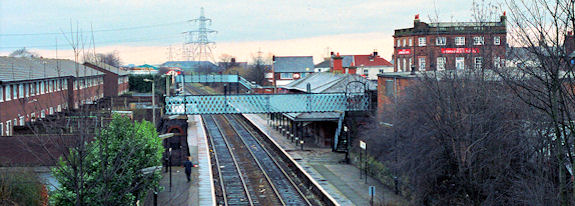
One of the world's oldest railway stations and the location of the Rainhill Trials of 1829
Station Road, Rainhill, Prescot, Merseyside L35 5SN
The Rainhill Trials, run at Rainhill in 1829, marked a seminal moment in the development of steam locomotive railways.
The Liverpool and Manchester Railway - the world's first inter-city passenger railway - was nearing completion and the directors of the railway ran a competition to determine whether stationary steam engines or locomotives should haul the trains. Each of the judges was a highly respected engineer - John Urpeth Rastrick, a locomotive engineer of Stourbridge; Nicholas Wood, a mining engineer from Killingworth with considerable locomotive design experience; and John Kennedy, a Manchester cotton spinner and a major proponent of the railway. The procedure was highly scientific, with a loading equivalent to three times the locomotives own weight, and each had to travel a distance equal to a return journeu from Liverpool to Manchester.
Five locomotives presented for the competition, run over the course of several days. "Cycloped" by Thomas Brandreth, utilised a horse walking on a drive belt, and was quickly withdrawn after the horse passed through the floor. "Perserverence" by Timothy Burstall, failed to achieve the 16 km/h (10 mph) minimum speed on the first day and retired next. Timothy Hackworth's "Sans Pareil" exceeded the maximum permitted weight, but was allowed to compete until it cracked a cylinder. "Novelty", produced by John Ericsson and John Braithwaite, was lighter and quicker than most of the competition, but suffered a cracked boiler pipe which could not be repaired. George Stephenson's "Rocket" was the only locomotive to complete the trials, achieving a top speed of 48 km/h (30 mph) while hauling thirty tonnes. As the winner of the competition, Stephenson received the contract to produce locomotives for the Liverpool & Manchester Railway.
Rainhill Station is one of the oldest stations in the world, opening a year after the Trials in 1830. The first record of substantial buildings at Rainhill were mentioned in a Board instruction to erect "a large waiting room" in 1841, although the present building is much more than that. Under the amalgamation of 1846, the LMR and the Grand Junction Railway became part of the LNWR's Northern Division, with the station design at Rainhill closely aligned to GJR practice. The long, two-storey hipped-roof building has a pitched wrap-round canopy supported by arcades of segmental open cast-iron beams and highly decorated brackets between wooden posts. The building is formed from brick, with fluted stone door and window casing giving a delicate touch. It has a latticed iron footbridge and a standard wooden LNWR signal box on a brick base (1899).
George Stephenson designed and constructed the Skew arch bridge at the west end of the station, the first skew to ever cross a railway. This handsome bridge, which carried the Liverpool to Warrington Turnpike, has a span of 54 ft on a skew of 34 degrees, the most acutely angled of the sixteen skew bridges on the LMR. Like the station, it is now a listed building.
The following Grand British Experimental Railway documentary was made by Granada TV in 1980 . It celebrates the 150th anniversary of the Liverpool-Manchester railway. Presenter Bob Greaves takes a trip on today's line and introduces a dramatised reconstructions of important facets of the railway's construction and history, including the Rainhill Trials, Edge Hill Station and the building of the Sankey viaduct.
By road: Off A57

Barman, Christian, An Introduction to Railway Architecture, Art & Technics, (1950)
Biddle, Gordon, Great Railway Stations of Britain, David & Charles, ISBN 0 7153 8263 2 (1986)
Biddle, Gordon, Britain's Historic Railway Buildings, Oxford University Press, ISBN-10: 0198662475 (2003)
Biddle, Gordon, Victorian Stations, David & Charles, ISBN 0 7153 5949 5 (1973)
Biddle, Gordon & Nock, O.S., The Railway Heritage of Britain : 150 years of railway architecture and engineering, Studio Editions, ISBN-10: 1851705953 (1990)
Biddle, Gordon and Simmons, J., The Oxford Companion to British Railway History, Oxford, ISBN 0 19 211697 5 (1997)
Biddle, Gordon,and Spence, Jeffry, The British Railway Station, David & Charles, ISBN 0 7153 7467 2(1977)
Burton, Anthony, The Rainhill Story: The Great Locomotive Trial, BBC Books, ASIN:B002LWAGB8 (1980)
Butt, R.V.J. The Directory of Railway Stations, Sparkford: Patrick Stephens Ltd. ISBN 1-8526-0508-1. (October 1995, 1st Edition)
Conolly, W. Philip, British Railways Pre-Grouping Atlas And Gazetteer, Ian Allan Publishing, ISBN 0-7110-0320-3 (1958/97)
Gibbon, Richard, Stephensons Rocket and the Rainhill Trials, Shire, ISBN-10:0747808031 (2010)
Hall, Stanley, Rail Centres: Manchester. ISBN 0-7110-2356-5 (1995)
Holt, Geoffrey, A Regional History of the Railways of Britain, North West. ISBN 0 7153 7521 0 (1978)
McGowan, C., The Rainhill Trials: The Birth of Commercial Rail, Little, Brown & Co, ISBN-10: 0316724807 (2004)
Simmons, J., The Railways of Britain, Macmillan, ISBN 0 333 40766 0 (1961-86)
Simmons, J., The Victorian Railway, Thames & Hudson, ISBN 0 500 25110X (1991)
BBC - World's First Passenger Railway
The History of Transport in Sutton
The Rainhill Railway & Heritage Society
The Rainhill Trials of 1829 - Virtual Museum
Spartacus Educational - George Stephenson